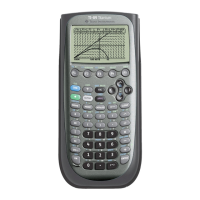TI-83, TI-83 Plus, TI-84 Plus Guide
Chapter 3 Determining Change: Derivatives
3.3 Exponential and Logarithmic Rate-of-Change Formulas
The calculator only approximates numerical values of slopes – it does not give a slope in
formula form. You also need to remember that the CALCULATOR calculates the slope (i.e.,
the derivative) at a specific input value by a different method than the one we use to calculate
the slope.
DERIVATIVE NOTATION AND CALCULATOR NOTATION In addition to learning
when your calculator gives an acceptable answer for a derivative and when it does not, you
also need to understand the differences and similarities in mathematical derivative notation and
calculator notation. The notation that is used for the calculator’s numerical derivative is
nDeriv(f(x), x, x). The correspondence between the mathematical derivative notation
df x()
dx
and
the calculator’s notation
nDeriv(f(x), x, x) is illustrated in Figure 5.
Figure 5
We illustrate another use of the calculator’s derivative by constructing Table 3.7 in Section 3.3
of Calculus Concepts. The table lists x, y = f(x) = e
x
, and y′ =
df
dx
for 4 different inputs. We
next evaluate this function at these 4 and several other inputs.
You can evaluate the CALCULATOR numerical derivative on
the home screen or in the table. We choose to use the table.
Enter the function f in the
Y= list, say in Y1. In Y2 enter the
numerical derivative evaluated at a general input
X.
Press 2nd WINDOW (TBLSET) and choose ASK in the Indpnt:
location. Access the table with
2ND GRAPH (TABLE) and
delete or type over any previous entries in the
X column. Enter
the values for
X that are shown on the screen to the right.
It appears that the derivative values are the same as the function outputs. In fact, this is a true
statement for all inputs of f – this function is its own derivative.
You can use the methods discussed on pages 35 and 35 of this Guide to find the values
used in Table 3.9 in Section 3.3 of Calculus Concepts to numerically estimate
h
h
h
→
−
0
21
lim
.
Instead, we explore an alternate method of confirming that
d
dx
x
(2 )
= (ln 2) 2
x
.
Copyright © Houghton Mifflin Company. All rights reserved.
55

